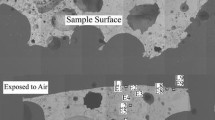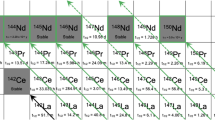Abstract
We analyzed the Zn isotopic compositions of nuclear debris samples from atmospheric and underground nuclear tests. Samples from the site of atmospheric tests exhibit a range of Zn isotopic fractionation (δ66ZnJMC-Lyon = 0.23–0.86 ‰) while samples from underground tests exhibit Zn isotopic compositions with minimal variation among samples and from terrestrial igneous rock standards (δ66ZnJMC-Lyon = 0.28–0.39 ‰). The larger range of δ66ZnJMC-Lyon observed in atmospheric test samples relative to underground test samples is likely the result of the open system characteristics of atmospheric nuclear tests and the closed system characteristics of underground nuclear tests.







Similar content being viewed by others
Data availability
All relevant data are available in the main text.
References
United States Department of Energy (2000) United States nuclear tests: July 1945 through September 1992, DOE/NV-209 (Rev. 15), National Nuclear Security Administration Nevada Field Office
Albarede F (2004) The stable isotope geochemistry of copper and zinc. In: Johnson CM, Beard BL, Albarede F (eds) Geochemistry of non-traditional stable isotopes. Mineralogical Society of America, Washington, pp 409–427
Ben Othman D, Luck JM, Bodinier JL, Arndt NT, Albarède F (2006) Cu–Zn isotopic variations in the Earth’s mantle. Geochim Cosmochim Acta 70:A46
Cloquet C, Carignan J, Lehmann MF, Vanhaecke F (2008) Variation in the isotopic composition of zinc in the natural environment and the use of zinc isotopes in biogeosciences: a review. Anal Bioanal Chem 390:451–463
Herzog GF, Moynier F, Albarède F, Berezhnoy AA (2009) Isotopic and elemental abundances of copper and zinc in lunar samples, Zagami, Pele’s hairs, and a terrestrial basalt. Geochim Cosmochim Acta 73(19):5884–5904
Telus M, Dauphas N, Moynier F, Tissot FLH, Teng F-Z, Nabelek PI, Craddock PR, Groat LA (2012) Iron, zinc, magnesium and uranium isotopic fractionation during continental crust differentiation: the tale from migmatites, granitoids, and pegmatites. Geochim Cosmochim Acta 97:247–265
Chen H, Savage PS, Teng FZ, Helz RT, Moynier F (2013) Zinc isotope fractionation during magmatic differentiation and the isotopic composition of the bulk Earth. Earth Planet Sci Lett 369:34–42
Doucet LS, Mattielli N, Ionov DA, Debouge W, Golovin AV (2016) Zn isotopic heterogeneity in the mantle: a melting control? Earth Planet Sci Lett 451:232–240
Luck JM, Othman DB, Albarède F (2005) Zn and Cu isotopic variations in chondrites and iron meteorites: early solar nebula reservoirs and parent-body processes. Geochim Cosmochim Acta 69(22):5351–5363
Moynier F, Albarède F, Herzog GF (2006) Isotopic composition of zinc, copper, and iron in lunar samples. Geochim Cosmochim Acta 70(24):6103–6117
Paniello RC, Day JM, Moynier F (2012) Zinc isotopic evidence for the origin of the Moon. Nature 490(7420):376–379
Kato C, Moynier F, Valdes MC, Dhaliwal JK, Day JM (2015) Extensive volatile loss during formation and differentiation of the Moon. Nat Commun 6(1):7617
Day JM, Moynier F, Meshik AP, Pradivtseva OV, Petit DR (2017) Evaporative fractionation of zinc during the first nuclear detonation. Sci Adv 3(2):e1602668
Wimpenny J, Marks N, Knight K, Rolison JM, Borg L, Eppich G, Badro J, Ryerson FJ, Sanborn M, Huyskens MH, Yin QZ (2019) Experimental determination of Zn isotope fractionation during evaporative loss at extreme temperatures. Geochim Cosmochim Acta 259:391–411
Ross CS (1948) Optical properties of glass from Alamogordo, New Mexico. American Mineralogist: Journal of Earth and Planetary Materials 33(5–6):360–362
Belloni F, Himbert J, Marzocchi O, Romanello V (2011) Investigating incorporation and distribution of radionuclides in trinitite. J Environ Radioact 102(9):852–862
Cassata WS, Prussin SG, Knight KB, Hutcheon ID, Isselhardt BH, Renne PR (2014) When the dust settles: stable xenon isotope constraints on the formation of nuclear fallout. J Environ Radioact 137:88–95
Eby GN, Charnley N, Pirrie D, Hermes R, Smoliga J, Rollinson G (2015) Trinitite redux: mineralogy and petrology. Am Miner 100(2–3):427–441
Lewis LA, Knight KB, Matzel JE, Prussin SG, Zimmer MM, Kinman WS, Ryerson FJ, Hutcheon ID (2015) Spatially-resolved analyses of aerodynamic fallout from a uranium-fueled nuclear test. J Environ Radioact 148:183–195
Bonamici CE, Kinman WS, Fournelle JH, Zimmer MM, Pollington AD, Rector KD (2017) A geochemical approach to constraining the formation of glassy fallout debris from nuclear tests. Contrib Miner Petrol 172:1–23
Adams CE, Farlow NH, Schell WR (1960) The compositions, structures and origins of radioactive fall-out particles. Geochim Cosmochim Acta 18(1–2):42–56
Melosh HJ, Vickery AM (1991) Melt droplet formation in energetic impact events. Nature 350(6318):494–497
Wood DB (2007) Digitally available interval-specific rock-sample data compiled from historical records, Nevada National Security Site and Vicinity, Nye County, Nevada. Data Series DE-A152-07NA28100
Rosca C, König S, Pons ML, Schoenberg R (2021) Improved protocols for Zn purification and MC-ICP-MS analyses enable determination of small-scale Zn isotope variations. Chem Geol 586:120440
Chen S, Liu Y, Hu J, Zhang Z, Hou Z, Huang F, Yu H (2016) Zinc isotopic compositions of NIST SRM 683 and whole-rock reference materials. Geostand Geoanal Res 40(3):417–432
Yang Y, Zhang X, Liu SA, Zhou T, Fan H, Yu H, Cheng W, Huang F (2018) Calibrating NIST SRM 683 as a new international reference standard for Zn isotopes. J Anal At Spectrom 33(10):1777–1783
Maréchal CN, Télouk P, Albarède F (1999) Precise analysis of copper and zinc isotopic compositions by plasma-source mass spectrometry. Chem Geol 156:251–273
Bigalke M, Weyer S, Kobza J, Wilcke W (2010) Stable Cu and Zn isotope ratios as tracers of sources and transport of Cu and Zn in contaminated soil. Geochim Cosmochim Acta 74(23):6801–6813
Moynier F, Beck P, Yin QZ, Ferroir T, Barrat JA, Paniello R, Telouk P, Gillet P (2010) Volatilization induced by impacts recorded in Zn isotope composition of ureilites. Chem Geol 276(3–4):374–379
Moynier F, Paniello RC, Gounelle M, Albarède F, Beck P, Podosek F, Zanda B (2011) Nature of volatile depletion and genetic relationships in enstatite chondrites and aubrites inferred from Zn isotopes. Geochim Cosmochim Acta 75(1):297–307
Moeller K, Schoenberg R, Pedersen RB, Weiss D, Dong S (2012) Calibration of the new certified reference materials ERM-AE633 and ERM-AE647 for copper and IRMM-3702 for zinc isotope amount ratio determinations. Geostand Geoanal Res 36(2):177–199
Sossi PA, Halverson GP, Nebel O, Eggins SM (2015) Combined separation of Cu, Fe and Zn from rock matrices and improved analytical protocols for stable isotope determination. Geostand Geoanal Res 39(2):129–149
Sossi PA, Nebel O, O’Neill HSC, Moynier F (2018) Zinc isotope composition of the Earth and its behaviour during planetary accretion. Chem Geol 477:73–84
Wang ZZ, Liu SA, Liu J, Huang J, Xiao Y, Chu ZY, Zhao XM, Tang L (2017) Zinc isotope fractionation during mantle melting and constraints on the Zn isotope composition of Earth’s upper mantle. Geochim Cosmochim Acta 198:151–167
Suhr N, Schoenberg R, Chew D, Rosca C, Widdowson M, Kamber BS (2018) Elemental and isotopic behaviour of Zn in Deccan basalt weathering profiles: chemical weathering from bedrock to laterite and links to Zn deficiency in tropical soils. Sci Total Environ 619:1451–1463
Rosca C, Schoenberg R, Tomlinson EL, Kamber BS (2019) Combined zinc-lead isotope and trace-metal assessment of recent atmospheric pollution sources recorded in Irish peatlands. Sci Total Environ 658:234–249
Archer C, Andersen MB, Cloquet C, Conway TM, Dong S, Ellwood M, Moore R, Nelson J, Rehkämper M, Rouxel O, Samanta M (2017) Inter-calibration of a proposed new primary reference standard AA-ETH Zn for zinc isotopic analysis. J Anal At Spectrom 32(2):415–419
Mughabghab SF, Divadeenam M, Holden NE (1973) Neutron cross sections. Volume 1: Neutron resonance parameters and thermal cross sections, Part A: Z=1–60. National Neutron Cross section Center, Brookhaven national Laboratory, Associated Universities, Incorporated
Funding
Research presented in this publication was supported by the Laboratory Directed Research and Development program of Los Alamos National Laboratory under project number 20210215DR. This document is approved for unlimited public release through Los Alamos National Laboratory under LA-UR-23-30659.
Author information
Authors and Affiliations
Contributions
All authors contributed to the study conception and design. Sample preparation was performed by MAB. Sample processing, analysis, and data collection were performed by ZAT. The first draft of the manuscript was written by ZAT, and MAB and MES each provided substantial contributions to the written text. All authors read and approved the final manuscript.
Corresponding author
Ethics declarations
Conflict of interests
The authors have no competing interests to declare that are relevant to the content of this article.
Additional information
Publisher's Note
Springer Nature remains neutral with regard to jurisdictional claims in published maps and institutional affiliations.
Rights and permissions
Springer Nature or its licensor (e.g. a society or other partner) holds exclusive rights to this article under a publishing agreement with the author(s) or other rightsholder(s); author self-archiving of the accepted manuscript version of this article is solely governed by the terms of such publishing agreement and applicable law.
About this article
Cite this article
Torrano, Z.A., Boggs, M.A. & Sanborn, M.E. The distinct conditions of atmospheric and underground nuclear tests revealed by Zn isotopic compositions of nuclear debris samples. J Radioanal Nucl Chem 333, 805–814 (2024). https://doi.org/10.1007/s10967-023-09291-8
Received:
Accepted:
Published:
Issue Date:
DOI: https://doi.org/10.1007/s10967-023-09291-8




